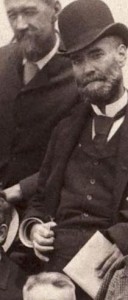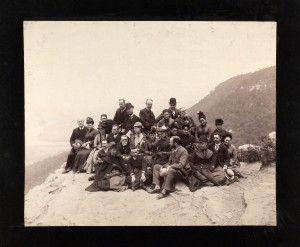The ongoing processing of the Society’s Group Photograph collection has recently turned up a small cache of nineteenth-century photographs of librarians. Oh sure, there are also significant photographs of mill workers, school children, and important businessmen, but around here we get pretty jazzed up over images of librarians. On the whole, librarians tend to be a shy bunch, not prone to self-aggrandizement. So, images of nineteenth-century librarians, taken as our profession was being crafted, cause great excitement. When this cluster of eight photographs of American Library Association outings turned up during our survey, we were all intrigued.
The photographs were taken at the time of the A.L.A’s annual meetings and range in date from 1887 to 1897. They show large groups of men and women gathered in a variety of locations, from Look-Out Mountain in Tennessee to Nova Scotia, Canada. The photographs were intended as mementos of these occasions. Those in attendance gather in their top coats and fancy hats, out-of-doors where the photographer had a chance of getting enough light. Both Edmund Mills Barton (1838-1918), the Antiquarian Society’s Librarian, and Charles Augustus Chase (1833-1911), who served as AAS’s Council secretary and held terms on both the finance and publications committees, attended A.L.A. events. The photographs ended up in our holdings through these men. Several are annotated on the reverse with a list of participants, or included printed lists of attendees.
The images get right at the heart of librarianship, paralleling the growth of the A.L.A., the national professional organization which was founded in 1876 to “enable librarians to do their present work more easily and at less expense.” The A.L.A., by the way, is still very much in existence today and holds conferences and training around the country to benefit the professional development of libraries and library staff. For more information on the ALA or this year’s annual conference in Washington, D.C. from June 24-29, 2010, you can click here.  The nineteenth-century participants in the photographs range widely in age, from men with graying beards to young women with nary a wrinkle. They appear well-dressed. All are white, even though, as we learned in an earlier blog post, Daniel Alexander Payne Murray, the Assistant Librarian of Congress, was an African American. Not surprisingly for such a bookish group, many wear glasses.
The nineteenth-century participants in the photographs range widely in age, from men with graying beards to young women with nary a wrinkle. They appear well-dressed. All are white, even though, as we learned in an earlier blog post, Daniel Alexander Payne Murray, the Assistant Librarian of Congress, was an African American. Not surprisingly for such a bookish group, many wear glasses.
In addition to these photographs, the Society holds many nineteenth-century publications printed by the American Library Association, including bibliographies, indexes to periodicals, papers read before the group at various conferences, and Barton’s own reflection, The First Conference of American Librarians, a pamphlet printed in 1886. Material related to the A.L.A. meetings is housed in our classed collections under both Libraries and Institutions, two groups of material accessible at present only through the auspices of our Reference staff. In addition, Barton’s correspondence in the Society’s archives documents how closely the Society was participating in the early days of librarianship.
This summer, as during most summers, AAS will employ a clutch of students from a number of colleges and universities. The students will work on a wide variety of projects, from updating holdings records for newspapers and serials to sorting and cataloging materials from those complex classed collections, including Institutions. Our past experience indicates that some of these students will likely choose librarianship as a profession. Thus these young people are the followers of those individuals captured in the group photographs. And, although they may not yet have travelled to an A.L.A. conference and they probably do not own such magnificent hats, many of them do wear glasses!


Very cool! Thank you for sharing. Are these currently accessible to researchers or are they tied up in processing? I would love to look at them. Early images are hard to come by. While I haven’t done any concerted research on librarians’ dress I’m interested in looking at how conservative or fashion-forward the profession might have been.
Beth,
The photographs are still being processed, but they are certainly available in our reading room. Seven of the eight have also been scanned. If you would like copies for your research, you can certainly contact our Rights & Reproduction department via the AAS website http://www.americanantiquarian.org/reproductions.htm.
I love your topic of research — wait until you see some of the hats!